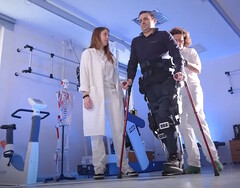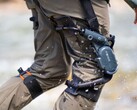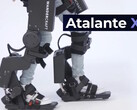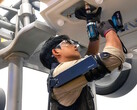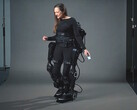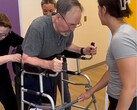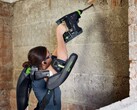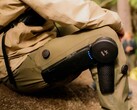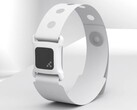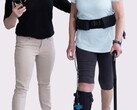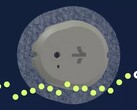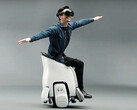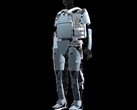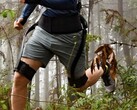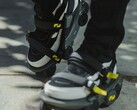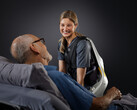Rehab Technologies IIT has presented in Milan the TWIN exoskeleton for stroke and spinal cord injury patients with limited lower limb control. The suit assists patients while sitting, standing, and walking about or during rehabilitation, but some staff assistance is required because it is not self-balancing like the Wandercraft Personal Exoskeleton.
Exoskeletons have been in use commercially by warehouse workers and even nurses to provide a boost in strength while reducing injuries while lifting heavy things. However, these suits are designed for a healthy individual, not for the patient with limited, lower-limb mobility.
Two big challenges during stroke or spinal cord rehabilitation is moving the limbs frequently and in a natural manner that aids physical recovery. Commonly, patients are tethered to the ceiling or held from behind to guard against falls while a physical trainer moves the legs over and over during walk training. Repeating normal movements helps retrain the brain to control the body better.
The TWIN exoskeleton helps patients who need assistance moving their legs rehabilitate in “TwinCare” mode where weak knee and hip muscles are assisted by motors. Users who can walk on their own, but want to walk more normally can use the “Retrain mode” to help move their legs through an optimized gait. “Walk mode” helps fully lower-limb disabled patients walk with a preprogrammed gait. During training, a trainer can use an Android tablet to control modes, adjust movement range and boost, and execute programmed movements.
All modes eliminate the need for a physical trainer to manually move disabled limbs by hand during training sessions, but because the TWIN is not self-stabilizing, users must use crutches, strollers, or other assistance to remain balanced while walking about.
The lightweight exoskeleton made of aluminum and other light components is powered by a battery that runs for four hours and recharges in one. The suit is adjustable to fit most patients young and old.
Rehab Technologies will be seeking CE certification and a commercial manufacturer as their next step to brining the suit to the public. In the meantime, readers can track their health on long walks with a nice smartwatch (like this at Amazon).
Revolutionizing mobility with the introduction of TWIN robotic exoskeleton
TWIN is the name of the new robotic exoskeleton for lower limbs, designed and developed by Rehab Technologies IIT – INAIL, the joint laboratory between the Istituto Italiano di Tecnologia (IIT-Italian Institute of Technology) and the Prosthetic Center of INAIL (the prosthetic unit of the National Institute for Insurance against Accidents at Work), which will allow patients to wear it more easily. Presented today in Milan during a press conference held at the Museum of Science and Technology, TWIN was demonstrated by two patients who were involved in testing the system during its development. TWIN is currently a prototype, but researchers hope to bring it to industrialization soon.
The exoskeleton TWIN originates from the IIT's Rehab Technologies Lab, which is the joint laboratory between the IIT in Genoa and the Prosthetic Center of INAIL in Budrio (Bologna), coordinated by Matteo Laffranchi. The collaboration began at the end of 2013 with the goal of developing innovative, high-tech, cost-effective solutions for patients with physical impairments.
One of the patients who wore TWIN today is Alex Santucci, who accompanied technicians and researchers throughout the entire design period of the device, participating in clinical experimentations as a tester. The clinical experiments took place not only at the Prosthetic Center of INAIL in Vigorso di Budrio but also at the Montecatone Rehabilitation Institute in Imola and at Villa Beretta in Costa Masnaga (LC).
The motorized exoskeleton TWIN is an external structure capable of enhancing the physical abilities of the wearer. It has been designed to allow individuals with reduced or even absent motor abilities in the lower limbs, such as in cases of complete spinal cord injuries, to maintain an upright position, walk with the assistance of crutches or walkers (as the exoskeleton is not self-balancing), and to stand up and sit down.
Two features make TWIN unique in the world: it is made of lightweight materials, such as aluminum alloy, and it is composed of modular components, facilitating usability and transportation. Furthermore, the structure is adjustable based on the patient's physical characteristics through telescopic links placed at the level of the femur and tibia. Ankles and foot support are available in various sizes to adapt to the ergonomics of the user, whether female or male, young or adult. TWIN's operating modes are also adaptable to the patient, evaluating the degree of motor deficit of the person wearing it, particularly their ability to perform autonomous walking.
TWIN can be controlled by an operator, such as a physiotherapist, using a specific Android application installed on the provided tablet. The graphical interface allows for controlling the exoskeleton in the execution of various programmed activities, setting the kinematic parameters of movement, and choosing between different step execution modes.
CHEMUK - Highlights from 2022 eBook Compilation of the top interviews, articles, and news in the last year.Download the latest edition
The exoskeleton works in three operating modes: 'Walk mode', designed for patients with absent motor function, in which the exoskeleton imposes a walking pattern according to programmed parameters; 'Retrain mode', used for patients with partial impairment of lower limb motor function, capable of performing a more or less autonomous movement but with difficulty in some phases of the step - in this case, the exoskeleton supports the patient's movement with more or less intensity, directing them towards an optimal reference trajectory; 'TwinCare mode', designed for patients with partial and differentiated motor impairment between the two limbs, where one leg is healthy and can move autonomously, while the other requires assistance, more or less pronounced, in some phases of the step.
The TWIN motors activate the knee and hip joints, imposing a completely configurable movement pattern on the patient's limbs, in terms of step length and type, and walking speed. The battery has a lifespan of approximately four hours and requires an hour to recharge.
In addition to rehabilitation clinics during physiotherapy sessions, TWIN can be worn daily, even for just a few hours, as assuming the upright position brings significant benefits in terms of musculoskeletal, circulatory, psychological, and digestive system functionality for wheelchair users.
TWIN's next goal is CE marking, which will occur in partnership with an industrial partner, followed by the industrialization process. Once TWIN is on the market, it can be used by patients in need, reintegrating severely injured workers into social and work environments.
Source:




